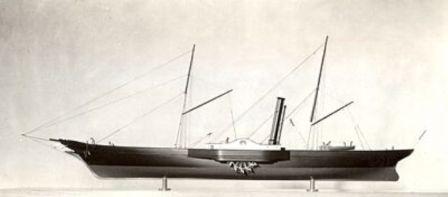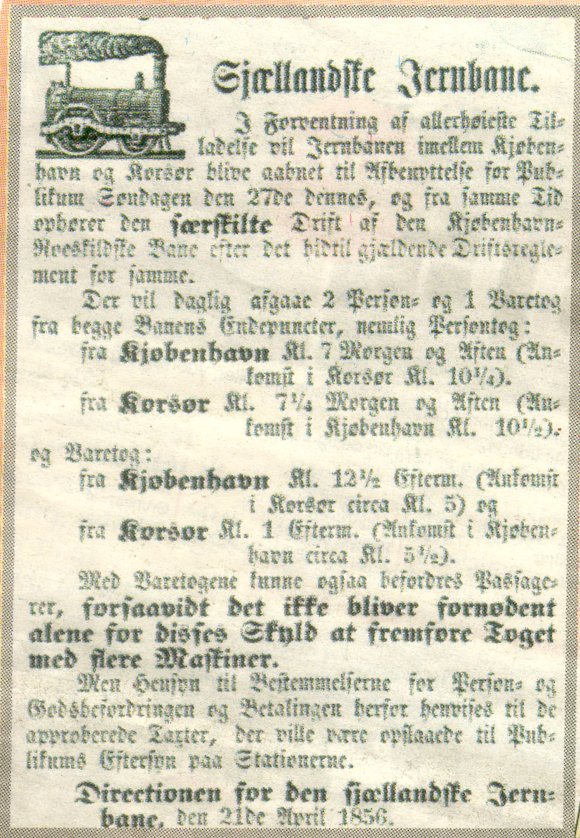|
Verne’s 2nd visit to Copenhagen
As mentioned initially Jules Verne was enthusiastic about sailing. During
the course of time he owned three ships, all by the name of “Saint Michel”.
The first two were smaller sailing boats; the third was a larger ship with
a steam engine, built in 1876 and bought by Verne in 1877 at a cost of
55,000 francs.
After several other trips aboard the “Saint Michel III” it was the plan
that a journey to the Baltic Sea region, with stops in Copenhagen, St.
Petersburg, Stockholm and Kristiania, should be made. This 2nd journey
is far better documented than the first. By 1881, Jules Verne was internationally
well known, the contemporary press wrote about the famous writers visit,
and Verne’s brother wrote a travelling journal “De Rotterdam a Copenhague”.
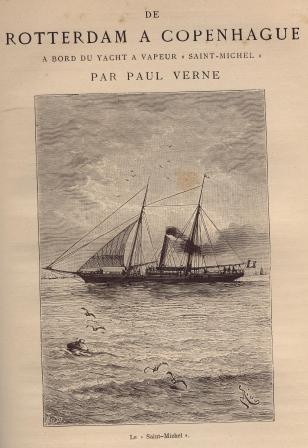
The summer sailing commenced at the end of May 1881. Besides the captain,
Ollive, the crew consisted of a marine engineer, two stokers, a chief steward,
three deck hands, a ships mate and a cook. The passengers were, besides
Jules Verne himself, Paul Verne and his son, Gaston, and a lawyer from
Amiens, Robert Godefroy. Rotterdam is reached by the 5th of June, and here
the ship has to wait for the weather to clear up. The 11th they continue
the journey via Rotterdam and Wilhelmshafen. Because of (probably well
founded) fears of the foul weather along the western coast of Jutland,
it is decided to go through the Ejder and the Ejderchannel to the Baltic
Sea. Back then, the channel was old, narrow and fitted with small locks.
Not until some years later, the far larger Kielerchannel was build. Due
to this, the ships bowsprit had to be disassembled to pass through the
locks. The 17th of June “St. Michel III” leaves Rendsburg, and arrives
at Kiel the same evening. The journey through Schleswig-Holstein is described
in very picturesque ways in Paul Vernes’ travelling journal.
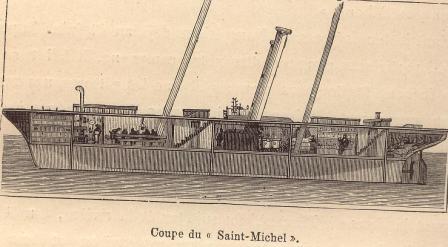
After a 24 hour stay in Kiel they sail at the evening of June the 18th,
heading towards Copenhagen. It is a beautiful, clear evening in the time
of the light summer nights and as soon as 7 AM the next morning the entry
to the Oresund strait is reached. At 10 AM they vaguely begin to see the
towers of Copenhagen through the misty weather. They berthed directly opposite
“Kvæsthusbroen”, where several ship routes to different locations
emanated at that time. “St. Michel III” stayed eight days in Copenhagen,
guests were entertained aboard and trips were made onshore.
The following is a citation from the journalist N. J. Berentsens’ account
of his interview-visit aboard:
“To the French, we tell the ferry by Nyhavns’ bridgehead”.
And onboard we meet Jules Verne, who wears his 53 years of age with splendour,
dressed in a reefer jacket with the red ribbon from the legion of honour
in his buttonhole, a flat cap and smoking a beautiful tiny meerschaum pipe.
Immediately at his approach, Jules Verne had greeted Our Saviours Churchs’
Tower as a good old acquaintance. Our museums he has heard a lot about.
He was especially looking forward to visiting the (museum of) Old Nordic
arts and reacquainting himself with Thorvaldsens.
Berentsen, among other things, writes in his recollections of the visit
that Verne did not know his books had been translated into Danish and
that he (Verne) the next day would visit the publisher and buy some copies,
which he also did. As I, on behalf of the publisher Andreas Schou apologized
for probably not having the means to honour the writer, he only smiled.
It made no difference to him.
Also the well renowned weekly magazine “Illustreret Tidende” visited
Verne onboard “St. Michel III”. Further reading and a description of the
ship later.
Of the Copenhagen sights Paul Verne mentions in his travelling journal,
especially the museums the Ethnographical Collection, Museum of Old Nordic
Arts and the Rosenborg Collection deserves attention. During the visits
at the two last mentioned museums, the tour was guided by chamberlain J.
J. A. Worsåe (1821-1885). Worsåe was the director of the museum
and had personally supervised the organization of these collections of
art. That Worsåe himself hosted these tours shows us, that Verne
was a gentleman of high repute, and not an ordinary tourist. Worsåe
was former Secretary of Culture, and the equivalence of his position would
in present time be director of the Cultural Heritage Authority. Thorvaldsens
museum was also paid a visit. One evening, perhaps Midsummer Day, the illuminated
Tivoli was visited, and this leaves a lasting impression with Paul Verne.
In the travelling journal several other of the buildings in Copenhagen
are mentioned, among them the Royal Exchange, Christiansborg Castle (which
burned down a few years later in 1884), Amalienborg Castle, Kgs. Nytorv,
the Royal Danish Theatre, Church of Our Lady, and, last but not least,
Church of Our Saviour at Christianshavn. Here, the account of Paul Verne
and his sons’ ascent of the tower will be reproduced. Apparently, Jules
Verne did not participate.
“After the Church of Our Lady, where the chorus is decorated by thirteen
statues by Thorvaldsen depicting Christ and the Apostles, I am bound to
mention the Church of Our Saviour at the island of Amager on the other
side of the harbour area. The building has no architectural significance
in itself, but it is dominated by a high tower, to the top of which you
can only find your way by the externally fitted ramp, which winds its way
in a helical line around the tower. It takes a sturdy heart to complete
this ascent. My brother has, in his “A journey to the centre of the Earth”,
allowed us to witness a “lesson in acrophobia” which professor Lidenbrock
teaches his nephew Axel on this staggering ramp.
The day my son and I made our ascension the weather was remarkably
clear. We could see all around us, the entire strait from the north to
the south, but a strong breeze from the east made all observation difficult.
It was hardly enough to hook on to the railing with both hands to stay
standing and resist the forceful wind pressure. Therefore, it was not possible
to make use of our binoculars. In this way, it was not possible for us
to recognize the flag of a fast going ship with two yellow chimneys arriving
at the roadstead of Copenhagen, and which saluted the Danish flag at the
Citadel with 21 gun salutes.
When you face north, you discover the little town of Elsinore at
the far end of the strait. A vast forest with gigantic trees and numerous
mansions in it stretches between Copenhagen and Elsinore. It is in this
forest, a veritable suburb of Copenhagen, and to which the beautiful “Langelinie”
promenade goes lengthways, that the wealthier Danish families have build
their summer residences. It is accessible by steamships, which services
the entire coastline and which docks at piers of iron or wood stretching
picturesque out onto the waters. It is a charming spot for a picnic, which
we intend to have tomorrow. We will go to Elsinore and pay a visit to Kronborg
Castle.
This Castle defends the northern entry to the strait, and it is
in this old fortress that Shakespeare has let the great scenes of his gloomy
tragedy “Hamlet” take place.
But no matter how interesting we found this remarkable panorama,
it was necessary to think about our departure; the locality was no longer
endurable: the wind gusts increased in violence and at certain moments
the tower seemed to sway forth and back at the immense powers.
My son, being less hardened than me, started to suffer from these
shakings which was particularly unpleasant because you were exposed to
them a hundred meters up in the air. His face began turning green, as if
he was seasick, his eyes looked dim… it was time for us to leave.
Therefore we started descending. No matter how used to mountainpaths
I was, this ramp which continues its helix into emptiness made a nasty
impression on me. Though not being as “green” as my son, I was already
pale, and not long time would have to pass until I would look like him.
We had descended approx. half a score of meters, when an unexpected
obstacle showed up.
A lady, about 50 years of age with a huge pink-coloured hat and
wearing an apple-green dress which in its shape mostly reminded of an umbrella
cover, blocked our path which was narrow enough even for just one person.
This lady, who must have been German, was accompanied by her eleven
children! Yes you read it correctly, her eleven children, and who says
she hasn’t got even more than that.
The procession which she led ended five or six meters further down,
with a very fat gentleman, without doubt her husband, sweaty, puffing and
completely wet.
What could you do? It was a tricky case. To go back up again was
impossible without exposing me to the storm again. The healthiest would
probably be to continue, but then it would be necessary to force the procession
back because bypassing it was not possible on this kind of path. It was
very embarrassing. The mother looked fiercely at me, and seemed to prepare
for battle. Her husband at the back, who could not understand the problem
uttered muffled grunts and occurred to be in a malicious mood. The best
thing was to negotiate with the new comers and try to make them turn back.
“We cannot go back madam, we cannot!” I say in a firm voice. “But dear
sir!” she answered me in Germanized French, which I succeeded in understanding
“we have the right to…” “Without doubt… But as you know there are certain
occasions where compulsion are prior to rights, and we are “compelled”
to go down!”. At the same time I showed her my son, whose person seemed
more and more frail. This was of sufficient significance for the entire
procession to turn around in great disarray without hesitation. It was
a matter of saving oneself if you could. In no more that 20 seconds the
ramp was cleared, the enemy had vanished, and we descended the 20 meters
which was between us and the inner stairway of the Church of Our Saviour
nice and easily.”
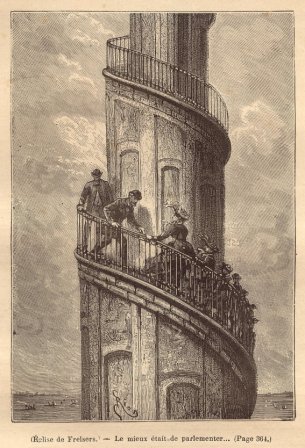
This was the account of Paul Verne. The trip to Elsinore was carried
out. Before the journey back home they witness the arrival of an English
naval party with the duke of Edinburgh on board on official visit. It was
a precursor of the navy that had been seen from the tower the day before.
The last days of the visit in Copenhagen are spent visiting the French
ambassador, and on a return visit from the ambassador on “St. Michel III”.
At close range, they watch King Christian the 9th disembark after visiting
the duke at the English navy party. Time is also taken for a trip to Frederiksberg
Garden.
All consideration concerning continuing the journey to other parts of
Scandinavia had been given up and the 26th of June, “St. Michel III” left
Copenhagen and sailed back home following the same route as they had used
on their way to Copenhagen: through the Ejderchannel to the North Sea.
Verne never came to Copenhagen again. In 1886 Verne sold “St. Michel
III” for 23,000 francs. Later that year Verne was wounded in his leg by
his nephew Gaston (Paul’s son, who was with him at the Church of Our Saviour)
by a gun shot. Gaston was mentally ill, and Verne never recovered fully.
Sources:
Paul Verne: “De Rotterdam a Copenhague” supplement to
the novel “La Jangada” 1881.
Frank Trende: (Ed.) “Jules Verne in Schleswig-Holstein”
Husum 2005. (A beautifully illustrated and commented version of Paul’s
account. Unfortunately severely reduced concerning the trip to Copenhagen.)
Letters from Jules Verne to Jules Hetzel in June 1881
“Illustreret Tidende”, 26th of June 1881
“Dags-Avisen” 21st of June1881, journalist N.J. Berendsens
summary of his visit to Jules Verne onboard “St. Michel III”. Republished
in an article in “Politiken” on the 14th of January 1959
A German translation of Paul Verne’s 1881-travelling journal: “Jules
Vernes baltische Reise” from 1987 published by Carl Brattstroem at the
publishing house “Cobra”
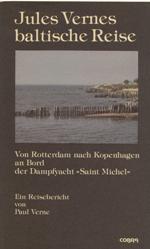
|

